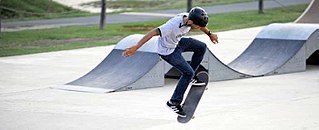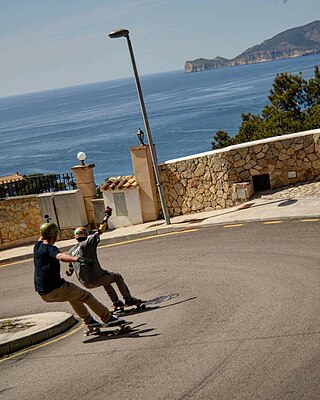
Snowboards are boards where the user places both feet, usually secured, to the same board. The board itself is wider than most skis, with the ability to glide on snow. Snowboards widths are between 6 and 12 inches or 15 to 30 centimeters. Snowboards are differentiated from monoskis by the stance of the user. In monoskiing, the user stands with feet inline with direction of travel, whereas in snowboarding, users stand with feet transverse to the longitude of the board. Users of such equipment may be referred to as snowboarders. Commercial snowboards generally require extra equipment such as bindings and special boots which help secure both feet of a snowboarder, who generally ride in an upright position. These types of boards are commonly used by people at ski hills, mountains, backcountry, or resorts for leisure, entertainment, and competitive purposes in the activity called snowboarding.

A skateboarding trick, or simply a trick, is a maneuver performed by manipulating a skateboard, usually with one's feet, in a specific way to achieve the desired outcome – the trick.

The kickflip is a skateboarding trick, in which the rider flips their skateboard 360° along the axis that extends from the nose to the tail of the deck. When the rider is regular footed the board spins counter-clockwise if viewed from the side.

John Rodney Mullen is an American professional skateboarder who practices freestyle skateboarding and street skateboarding. He is considered one of the most influential skaters in the history of the sport, being credited for inventing numerous tricks, including the flatground ollie, kickflip, heelflip, impossible, and 360-flip. As a result, he has been called the "Godfather of modern freestyle skating."

A longboard is a type of skateboard typified by longer decks and wheelbases, larger-diameter and softer (lower-durometer) wheels, and often lower riding height compared to street skateboards, though there is wide variation in the geometry and construction of longboards. Among the earliest types of skateboards, longboards were inspired by surfing, with early longboards drawing from the design of surfboards, resembling and mimicking the motion of riding a surfboard, but adapted to riding on streets in a practice known as sidewalk surfing.

Longboarding is typically defined as a variation of skateboarding that involves a larger board and softer urethane wheels. Longboards vary in shape and size. Compared to skateboards, longboards are more stable at speed and have more traction, due to larger wheel size and lower wheel durometers. A standard skateboard is typically between 28-34 inches long, whereas a longboard may exceed 50 inches. Many longboards use trucks that have different geometric parameters than skateboards. The skateboards use "traditional kingpin trucks" while longboards often use "reverse kingpin trucks." This hardware change is the key element in the increased stability that longboards offer.

The ollie is a skateboarding trick where the rider and board leap into the air without the use of the rider's hands. It is the combination of stomping, also known as popping, the tail of the skateboard off the ground to get the board mostly vertical, jumping, and sliding the front foot forward to level out the skateboard at the peak of the jump.
Footedness is the natural preference of one's left or right foot for various purposes. It is the foot equivalent of handedness. While purposes vary, such as applying the greatest force in a certain foot to complete the action of kick as opposed to stomping, footedness is most commonly associated with the preference of a particular foot in the leading position while engaging in foot- or kicking-related sports, such as association football and kickboxing. A person may thus be left-footed, right-footed or ambipedal.
In surfing, skateboarding, snowboarding and aggressive inline skating, frontside and backside are terms that are used to describe how a person approaches an obstacle or performs a certain trick. In aggressive inline skating, frontside and backside are types of grinds.

Freestyle BMX is bicycle motocross stunt riding on BMX bikes. It is an extreme sport descended from BMX racing that consists of five disciplines: street, park, vert, trails, and flatland. In June 2017, the International Olympic Committee announced that freestyle park was to be added as an Olympic event to the 2020 Summer Olympics.
A freestyle skateboarding trick is a trick performed with a skateboard while freestyle skateboarding. Some of these tricks are done in a stationary position, unlike many other skateboarding tricks. The keys to a good freestyle contest run are variety, difficulty, fluidity, and creativity. This is an incomplete list, which includes most notable tricks.
A flip trick is a type of skateboarding trick in which the skateboard rotates around its vertical axis, or its vertical axis and its horizontal axis simultaneously. The first flip trick, called a kickflip but originally known as a "magic flip", was invented by professional skateboarder Rodney Mullen.

In skateboarding, grinds are tricks that involve the skateboarder sliding along a surface, making contact with the trucks of the skateboard. Grinds can be performed on any object narrow enough to fit between wheels and are performed on curbs, rails, the coping of a skate ramp, funboxes, ledges, and a variety of other surfaces.

A slide is a skateboarding trick where the skateboarder slides sideways either on the deck or the trucks.
The no comply is a skateboarding trick that was invented by John Lucero and then named and popularized by the skater Neil Blender in the 1980s.

In skateboarding, a nollie, short for "nose ollie", is an ollie executed at the front of the board while the rider is positioned in their natural stance. Professional skateboarders Karl Watson, Shuriken Shannon, Tuukka Korhonen, and Sean Malto have been recognized for their ability to perform the nollie trick. A nollie can be easily confused with a fakie ollie, whereby the rider uses their original foot position but is instead riding backwards.

A caster board, vigorboard or waveboard is a two-wheeled, human-powered land vehicle. Other names are J-board and RipStik, both of which are derived from commercial brands.

A shove-it is a skateboarding trick where the skateboarder makes the board spin 180 degrees without the tail of the board hitting the ground under their feet. There are many variations of the shove-it but they all follow the same principle: The skateboarder's lead foot remains in one spot, while the back foot performs the "shove". The pop shove-it was originally called a "Ty hop", named after Ty Page.

Street skateboarding is a skateboarding discipline which focuses on flat-ground tricks, grinds, slides and aerials within urban environments, and public spaces. Street skateboarders meet, skate, and hang out in and around urban areas referred to as "spots," which are commonly streets, plazas or industrial areas. To add variety and complexity to street skateboarding, obstacles such as handrails, stairs, walls, flower beds, bins, park benches, picnic tables, and other street furniture may be traversed as single tricks or as part of a series of consecutive tricks called a "line."













